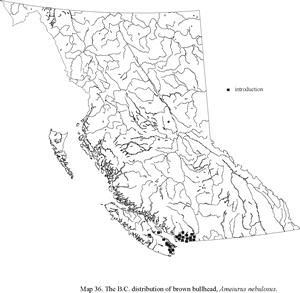Darkly pigmented barbels, strong serrations on the posterior edge of the pectoral spines, and usually 19-21 analy rays. Adults are yellow-brown above and dirty white below. Juveniles are dark above and white below. This species can be confused with the black bullhead (Ameiurus melas), however adults can be separated by the development of serrations on the trailing edge of the pectoral spines—these are srong in the brown bullhead and weak in the black bullhead. For further information see McPhail (2007). (Source: McPhail, J. D. 2007. The Freshwater Fishes of British Columbia. The University of Alberta Press. 620 p.)
Source: McPail, J. D. 2008. The Freshwater Fishes of British Columbia. University of Alberta Press, Edmonton.
